A new research report, Bicycling Trends and Policies in Large North American Cities prepared for the U.S. Department of Transportation, has found that Portland leads the pack in bike-friendliness among nine bike-centric cities in the U.S. and Canada.
The report, which takes a comprehensive look at all facets of cycling in Chicago, Minneapolis, Montréal, New York, Portland, San Francisco, Toronto, and Vancouver, was done by noted researchers John Pucher and Ralph Buehler.
Sharing the report with us via email last night, Pucher commented that, “As you will see, Portland comes out very, very well: THE BEST of all North American cities, by far.”
Pucher and Buehler looked at trends in bike ridership levels, safety, infrastructure, and policies over a 20 year period. They found that the number of bike commuters in the USA rose by 64% from 1990 to 2009, and the bike share of commuters rose from 0.4% to 0.6% (for comparison, in the shorter period of 1996 to 2006, the number of bike commuters in Canada rose by 42%, and the bike share of commuters rose from 1.1% to 1.3%.)
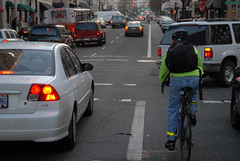
cars still dominate much of the urban
landscape. Here’s the view from a
major bike route in downtown Portland.
For each of the nine case study cities, the researchers offer a summary of each city’s, “innovations and lessons for other cities trying to increase cycling.”
Of Portland, they write in the Executive Summary:
“Portland does almost everything, but it is most notable for its bike boulevards, dense bikeway network, innovative bike corrals, large number of cycling events, and lively bike culture…
Portland is the American city that comes closest to implementing a truly comprehensive, well-integrated, long-term package of infrastructure, programs, and policies to promote cycling. Portland’s success is evident in the numbers, with a 6-fold increase in cycling levels since 1990, compared to a doubling in New York.”
Speaking of New York City, the city that has dominated the national discussion around bicycling lately due to bold measures taken by their DOT Commissioner and more recently the “bikelash” and lawsuit that has bubbled up as a result, the report has this to say:
“New York is a special case. Not only is New York by far the largest of the case study cities, but it has the most mixed record on cycling policies and accomplishments. Although cycling has almost doubled in New York City since 1990, it lags far behind the other case study cities in almost every respect. It has the lowest bike share of commuters, the highest cyclist fatality and injury rate, and the lowest rate of cycling by women, children, and seniors. New York has built the most bikeways since 2000 and has been especially innovative in its use of cycle tracks, buffered bike lanes, bike traffic signals, bike boxes, and sharrowed streets. Yet New York has almost completely failed in the important areas of bike-transit integration and cyclist rights and falls far short on bike parking and cycling training. Moreover, the refusal of New York’s police to protect bike lanes from blockage by motor vehicles has compromised cyclist safety. New York has much to learn from the other case study cities, which have implemented a far more comprehensive, integrated package of mutually reinforcing policies to promote cycling.”
This report is full of interesting lessons and comparisons. For instance, they found that climate does not appear to be a serious obstacle to increasing levels of bike use, “as shown by Portland and Vancouver, with their rainy climates, and Minneapolis and Montréal, with their long and very cold winters.” They also point out the regional differences in North American bike use, noting that the western states have by far the highest cycling rates, “while most states in the American South, from Texas all the way to North Carolina, have extremely low levels of cycling.”
According to the researchers, the success of Portland is important because, “it shows that even car-dependent American cities can greatly increase cycling by implementing the right package of infrastructure, programs, and policies.”
Coming on the heels of high praise of Portland from US DOT Secretary Ray LaHood during his visit this week, this study is yet another opportunity for us to bask in our success. While we agree that we deserve praise and Portland’s progress provides important inspiration for other cities, let’s not forget how much more work we have to do.
We need more kick in the pants and less pats on the back.
Download the full report here (PDF).



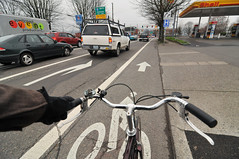
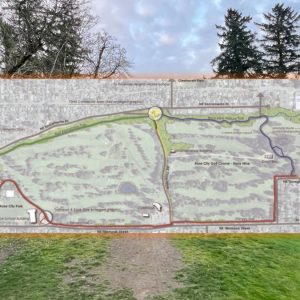
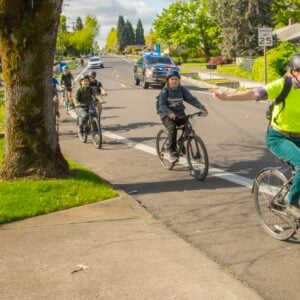
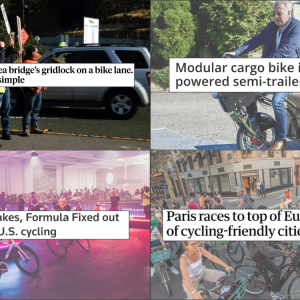
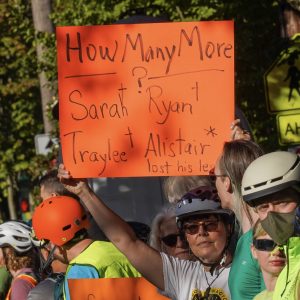
Thanks for reading.
BikePortland has served this community with independent community journalism since 2005. We rely on subscriptions from readers like you to survive. Your financial support is vital in keeping this valuable resource alive and well.
Please subscribe today to strengthen and expand our work.
Interesting writeup about NYC – ouch.
It’s great that we’re #1 of those 9 – I think it speaks a lot to the willingness of the city to make the needed changes, to the continued efforts of people like Mia Birk, Roger Geller, and the fine staff at PBOT, and the hard work of the BTA, PBAC, and countless advocates. Let’s not forget Shift and the projects of Shift alumni like Filmed By Bike, the various local rides, etc. as well as hundreds of extraordinary citizens who want Portland to be a better place to bike. Great beginning, everyone!
Now let’s leverage all that hard work of the past and use it to do bigger, better things. How about “Build It”? Let’s get that Bicycle Master Plan working. Keep the pressure on CRC to ensure that bikes/peds have a safe crossing no matter what option is implemented. Spread some bike love out of Portland proper and integrate with the suburbs in the counties. Develop regional connections for a truly statewide bicycle system (so we can prevent things like the hit and run in Molalla – on a road with a substandard shoulder). Let’s get a vehicular homicide law, some teeth to the vulnerable users law, better training for motorists and higher requirements for license renewals. And let’s evaluate our current bike infrastructure and replace the parts that aren’t working with ones that do.
Let’s aim for 20% mode share by 2020, and 40% by 2030. A lot has been done, but there’s so much more still to do, and we need to keep the pressure on, and keep motivating each other to excel, to do it better, and to keep riding. Let’s get to work!
Jonathan, I don’t think your piece makes clear enough that the global “bike-friendliness” conclusion in the study is really just about biking for transportation.
Remember, mtn biking still sucks in Portland thanks to the anti-sharing Forest Park crowd.
Gee, I dunno, I thought that was pretty clear.
It’s a study of 9 cities – I would think that’s self-evident. Granted, it’s been 20 years since I’ve been to NYC, but I don’t think mountain biking is really big there. You could as easily say “thanks to the anti-sharing Central Park crowd”. Even in a city with the opportunities that Portland has for wild experiences, developing mountain biking facilities in an urban region are challenging at best. most cities can’t do it, and this study addresses factors that are common in all 9 cities.
No, Matt, there is no organized effort to prevent mtn biking in Central Park. But that’s not true of Forest Park. And I’m going to go out on a limb and say New Yorkers would not be so silly about allowing such a use in a major city park.
And let’s keep in mind that this is just a comparison study, yay we’re doing better… Which only means something compared to the 8 other cities in the study. I wish they’d compared to other cities that weren’t in NA, like cities in Europe and Asia.
According to a presentation from IMBA:
At Jefferson County Open Space outside Denver, Colorado, more than 3,000,000 visitors, including mountain bikers, share 250 miles of multi-use trail.
In Kansas City, Missouri, land managers and mountain bikers are developing more than 100 miles of trail on city open space land.
In Salt Lake City, Utah, mountain bicyclists continue to support open space acquisitions to preserve land for generations to come.
In Mexico City, new mountain biking facilities are providing millions of people fun, healthy, outdoor opportunities.
Mountain Biking Boston Trail Guide lists 45 area singletrack trails within a 60 mile radius of Boston.
In Charlotte, NC, with 35 miles of singletrack trails in 6 different park systems, all Charlotte residents are within 10 miles of a trail system.
In Portland, OR, we have 6 miles of singletrack…..so lets all load up our bikes in our cars, contribute to global warming, and go for a mountainbike ride! THAT is reality.
I’m sure that the mountain bikers in Kansas City and Charlotte all ride to the trails from their houses…
There are plenty of options in town if you are looking for low-carbon ways to exercise. Don’t scapegoat other trail users when you decide to burn fossil fuels for exercise.
I don’t think you have any idea how mtn bikers in KC and Charlotte get to the trails.
This is shocking, given all of the complaining that goes on in this forum.
hey it’s rigormrtis! shhh, everybody. rigormrtis, what else do you have?
Hey Matt,
I agree that it’s difficult in an urban area, unless of course you have a huge Swath of wooded park in your zip code, which begs the question that keeps coming up: “why not us too?”
While I’d dig it if Portland built a “lower” wild wood trail for mountain biking etc, I understand the need to have a peaceful walk in the woods from time to time, and sometimes feel that cyclists tend to think they belong everywhere everyone else does, and I feel that it’s a bi-product of our success in integrating cyclists. The “Portlandia” vignette did a great job of shining a light on the sometimes self-absorbed cyclist culture that we need to do a better job of curtailing.
Anyone that’s ever poached the wildwood trail during late summer nights probably agrees that it’s truly a surreal experience. You ride along in a bubble of a head lamp on a perfectly groomed singletrack, sometimes stopped by deer, elk, or the occasional hobo in your path. After a few moments of contemplation you continue your ride, climbing, descending, twisting, turning, and shoving all the other crap out of your head while you simply focus on not hitting a tree.
You want to feel that amazing feeling every day of your life. You want this to be legal. You know though that if it was, the place would turn into a highway, it wouldn’t be any fun anymore, and hikers would have no place to go because they now feel like cyclists have chosen them as the next frontier against the non-cyclist crowd. So you stop poaching it, and you begin to understand something.
Cyclists have fought very hard over the years to get access to streets along side cars. We feel it’s a great way to commute, stay fit, and get a breath of fresh (if not moist) air on the way to and from work. We’ve made a crusade to become part of an environment that we don’t really belong in, and it’s a crusade we appear to be winning, albeit slowly. Along the way we’ve made allies to do so, and those allies are those that enjoy nature. They enjoy peace. They enjoy a nice walk in the woods, unencumbered by a hoard of cyclists looking for an adrenalin rush. They appreciate that we’re reducing the number of cars on the roads in the morning, and they appreciate the fact that we’re trying to help the environment that they enjoy walking around in.
So I say let them walk around in it, sans us. With little effort we have so much access to fantastic mountain biking within an hour or so of town, and it’s really not hard to get there. Find a friend with a car, split the gas money, and for heaven sakes, admit that some places we should avoid for our own health, those of others, and simply to place nice and share. It’s what cyclists should be known for doing, and it’s one of the thinks that would keep us at the top of this list year in and out.
thank you, thank you, thank you.
The first photo shows a bike lane that is non-compliant with MUTCD standards, i.e., it is to the right of a right turn lane. How is that resolved at the intersection? The second photo shows a right hook developing.
Not exactly the photos I would have picked to demonstrate a cyclist-friendly situation.
Khal, who said I was trying to pick a bike-friendly photo? My point in choosing those images was to remind people that it’s not all rainbows and unicorns when it comes to the bike network here in Portland. Yes, we are the best of the worst, but we are far from having a fully connected and safe system.
Jonathan, that’s absurd. You’re like the little kid who endoes on his face into a mud puddle and says “I meant to do that.”
Both those pictures are crappy bike lanes, and you couldn’t even tell they’re crappy. All bike lanes are good in your eyes.
Well, in that case, good show. I hope the irony was noted by others; apparently it was.
Seems to me that the hard part of installing bicycling architecture in a transportation system whose paradigm still is “its mostly about cars” is getting it done right rather than just getting it done. Some of our “Platinum level” bicycle facility designers are still not getting it that FTR can be a curse (i.e., “as far to the right as possible”). We do have a long way to go, even in progressive cities like Portland. Our cyclists need to be more vocal about not (literally) letting ourselves be painted into a corner when we should be staking out safer rider positioning when entering intersections.
I’m still convinced that it will take a ghastly increase in the overall costs and painfulness of urban auto operation to make a paradigm-shifting change in bike vs. car mode share but when that happens (as I think it will) we won’t have to be fighting a guerrilla war for fair roadway treatment any more.
As an old fart who has helped author two city bike plans (Los Alamos, 2005 and Honolulu, 1999), I know how much of a tall order it can be to make sure stuff gets done right the first time, not to mention that it gets done at all. Good luck out there on the Left Coast!
FYI, the commonly used acronym is FRAP: Far Right as Practicable, based on the statue language.
Indeed. There is a subtle semantic, but significant safety difference between “far right as possible” and “far right as practicable,” the latter which is the way the ORS is written.
I know what the statutes say, and what is often interpreted and enforce by bad design and bad enforcement. “As far right as is practicable” means that neither of those two pictures would ever be possible because the stripes wouldn’t have been painted there. Its not practicable to consistently ride to the right of right turning cars and then mysteriously find one’s self safely to the left of them.
This research report has to leave a lot of long time residents scratching their head’s. I’ve been a Portland resident for all of my sixty years. I grew up in Sellwood where I traveled everywhere by bike. By age eleven, my brother and I would re-spoke bike wheels for those who wanted wider rims. We charged two dollars per rim. I only mention all of this so as you don’t think I’m just another anti bike person of which there are many. I generally think most of these types are just jealous when they see people with more get up and go then they have. My only complaint with this report is it stretches the truth. Maybe to be more precise, it just doesn’t quite explain how they came to figures like 18% commuted to work in 2008. Some of this I know came from questions asked on the census. Did you ride your bike to work in 2008. Those who answered yes are included in these percentages even if they only rode one time. It’s great if they want to award Portland with top honors. We actually have a lot of bike commuters traveling downtown due to high parking costs. The rest of the city not so much. Anyone who travels around Portland will see that bike lanes are mostly empty. I’m just one of those who thinks Portland has invested well in it’s bike infrastructure. We should be proud of what we have, but lets not exaggerate things to the point of being ridiculous.
Mountain biking is a form of recreation, this article is talking about a form of transportation. I’m not sure that the ideas of building a more balanced transportation network by incorporating bikes is the same as taking ecologically vulnerable preserves & turning them into single use rollercoasters.
+1
LOL. The first photo depicts a bike lane to the right of a right turn only lane. If I wanted to create a design that would be better at killing bicyclists, I don’t know how to improve on this one. The second photo shows a bicyclist who has positioned himself at the mercy of the motorist on his left who is signaling right. What a perverse idea of “bike friendly”.
I went over the trunk of a car when I was right-hooked at the Broadway entrance to that exact gas station a couple years ago. Lady just kept driving up to the pump while I got up out of the lane of traffic.
yeah, better to take a ecologically vulnerable preserve and pave it.
great idea to illustrate this article with pictures showing that we have a long way to go to ensure safe bicycling infrastructure in Portland. the captions need to make that clear however.
There is no way around the problem that more segregation leads to more dangerous conditions (like those depicted in the photos) and less tolerance of cyclists on the roads. Some people believe that physically separated bike lanes, or cycle tracks, solve the safety issue, but by separating cyclists even more from other traffic, the problem at all intersection and driveways, where most crashes occur, is exasperated. Trying to improve bicycling with segregated facilities is like trying to douse a fire with gasoline.
Portland where are the offroad singletrack trails?
Mt Hood?
I’m talking about good singletrack in the city limits. Something that people can ride to and dont have to drive for a hour.
Of course NYC isn’t where Portland is, they’ve really only gotten behind bicycling for real for real in the past few years. Give it time, what they’re doing is super radical in the context of local transportation culture.
In Portland, we have made good strategic moves over decades, and we don’t have nearly the same density/traffic nightmares the NYC region battles with. I think this place is a much more hospitable place for the daily cyclist, and I predict NYC will come into its own (numbers wise) as time goes on.
We’re still working hard to have better mountain biking within Portland, or very close to it. Until then, I urge that Portland should absolutely NOT have platinum status. Period. I love commuting by bike in Portland, but I also like riding off road on singletrack. I should not have to choose between my environmental bent, and my love of mountain biking.
@ Matthew Williamson,
I find your logic disheartening, especially since it sounds like you are, or were, a mtb’er. You are basically arguing, please tell me if I’m wrong, that mtb’ers should back off of their preferred lifestyle choice (riding ST trails in the city so they do not have to drive a car for an hour to ride) so that they don’t poke the hornet’s nest (car drivers who also like to hike) so that said hornets do not react negatively to your preferred lifestyle choice (riding on the road). I would argue that there is no reason to “demonize” those who prefer to ride on dirt versus cement, and that all can coexist in all places peacefully. ‘I hope someday you will join us, and the world will live as one.” Sorry, been on a Beatles kick lately. Your colorful language for mountain bikers (hoards, adrenaline rush, etc.) only serves to drive that stake between user groups deeper and deeper. No mtb’ers I know (and I know quite a few) feel that they belong everywhere everyone else does–>more unnecessary, decisive language. Your post reminds me of the car vs debate bike language/logic that is used by the major media outlets in town. Different user groups can find common ground in the wild, much as they can on the cement. This is being accomplished all over the place by doing away with the us versus them mentality, and focusing on solutions. Mtb’ers are not anti-environment, and I would argue bring more resources to improve the environments they recreate in. Thanks for reading.
Brian
First off, I do both. I ride and I hike. I commute by bike in town, and I drive to see Grandma. Call me if you will, a moderate. Look at the top of my post. I suggested we build a second trail for mountain bikers, and leave the hikers alone. This isn’t education in the south, separate can sometimes be equal.
I’ll share a story with you first. My wife and I were hiking the University Falls trail network out at Brown’s camp this summer. I’ve mountain biked it a thousand times over in the past, and thought it’d be a nice place to walk along with my wife and dogs. It twists. it turns. In several places there’s limited visibility. In short, it’s exactly like the trails in Forest Park. At one point a Mountain biker came through one of my favorite corners (sharp bank, hard packed, good grip, and a straightaway that makes I-5 look like Lombard Street). It was no fault of his own, but there we were walking on the trail, when we all collided in a mass of aluminum and Birkenstock. In my mind nobody was really in the wrong. I mean..this corner was delivered by God himself to make every mountain biker feel like Tinker Juarez for just a moment. at the same time we were justified in being there. it was a bad situation that could have been made worse had reasonable people not been there. I hate to tell you this, but reason isn’t something we’re dealing with these days.
That said, I think the Wildwood trail is similar to that of Browns camp, but with more hikers, and more room for pain. it wouldn’t take long before a few ill-advised tight corners turned bloody, and then we’d suddenly alienate our allies.
Seriously people, let’s spend our time tasking out new trails with the volunteers to build them, instead of open up those that are already used for peaceful marches in the woods.
I’m sorry if you don’t like my language, but I hope instead you spend more time on the message.
The arguments used to bash mountain bikers remind me an awful lot of the ones once (and still used) to bash commuter cyclists.
Instead of attacking us (“roller coaster”? Get real. You’ve been watching too many Mountain Dew commercials. And gee, there are other low-carbon forms of recreation? really?) why not acknowledge that this clean, healthy recreation is underserved by our community? Plenty of cities have mountain biking opportunities — including my native Minneapolis, which has nearly a dozen MTB trail systems within its metro area — and I agree that Portland isn’t Platinum unless we do something about it. Jonathan’s right that we have much work ahead of us, and this is just one aspect of that.
If you don’t have any interest in mountain biking, fine. I don’t have any interest in riding the I-205 bike path: that doesn’t mean I need to attack those who would like it improved.
I’m not attacking you. I’ve been racing OBRA and IMBA events for the better part of 10 years, and I feel that instead of *getting real*, I’d try to be a bit more real*istic*.
Maybe I haven’t been watching *enough* mountain dew commercials, as they’re able to close the trails off for shoots, and it’d create a nice safe reality free of an opposing viewpoint.
Sure, it’s clean and healthy recreation, but it’s also potentially dangerous to those around when they collide with mountain bikers, causing a lot more pain than gain.
Seriously, if you want a good ride in town, work to build more trails that are well posted with their use, paid to be maintained and the ecology protected, volunteer to help, and fix the problem instead of bitching that people walking in the woods want to do it without getting maimed, and that heaven forbid, a mountain biker can respect and agree with them.
Until then, get 3 friends, split the gas money, and pay the price of a couple of power bars to get out to Hagg Lake, hood river, Mckenzie River, Blue River, Blodgett, or Bend to get your fix. There’s a huge difference between the aim of this article (bicycle transportation), and mountain biking (bicycle recreation), both areas I’m passionate about, and both that I understand and identify with.
Matthew,
I don’t think you are being realistic, or maybe aren’t knowledgable enough on the situation in FP, when you say “just build another trail.” The hurdles to that are tremendous. We are working for just that in the long term. In the meantime, there are plenty of opportunities to share existing trails in FP in a way that works for all (and helps the park, in general). This can happen in a number of ways that have been discussed thoroughly on BP. Not a single person I know is advocating for opening up WW to us, and there are many more trails suitable to sharing. How will we have data on trail sharing for future decisions, unless we give it a chance and establish a baseline? You seem to buy into the fear based ideas of our opponents, but have no data to support it. There are multi use trails all over the country, and they work. Hell, anyone who has ridden or hiked on many of the trails on Hood know this is workable. The last time I rode Coyote Canyon at Syncline I saw twice as many hikers as bikers, and I enjoyed stopping to greet and talk each of them. I hope you are willing to use real data to consider the possibility that your message may need some editing.
Cheers,
Brian
Lastly, the cost to drive to some of the places you mentioned is far more than a couple of Power bars. It takes a full tank of gas, in the neighborhood of $45. That’s $15 each for a 3 hour ride at McKenzie River Trail, and six hours in the car. It’s just not realistic to expect people to do that, especially when they want to ride multiple days a week (including after work during the week). I don’t think you are the one being realistic.
Matt, my comments about bashing weren’t directed towards you.
On another note, echoing Brian I suspect you may be unfamiliar with recent developments regarding Forest Park. Many, many people have worked tirelessly for many, many years for legal singletrack in FP, to no avail. Except for a couple of short connector segments, last year’s round in which we were once again denied was mostly a proposal for exactly what you suggest: NEW bike-specific trail in an area of the park already designated as heavily impacted by human activity and with low wildlife value.